What to smear on the teeth so that they do not fall out

A well-documented patient does not need anesthesia.
Due to numerous requests from workers today we will deal with very important issues:
- How to brush your teeth with your finger?
- Do seals dissolve well in acid?
- Why does it hurt when you drill your teeth without anesthesia?
- Why brush your teeth with green paint?
- Treatment of caries at home
- Deep microfluorination of enamel
Let's go over a bit on the boring topic of the structure of the tooth and immediately plunge into the exciting world of countless beasts that eat you alive, and a variety of useful dental bubbles and tubes.
Tooth structure

Cutter cutter. Polarized microscopy in the region of the cutting edge (A), macro photograph on Nikon D300 (B), polarized microscopy in the region of the tooth neck (C)
Hard tooth tissue consists of three main elements: enamel, dentin and cement. Cement will not touch, it is not relevant to us now. Let's look at the other two. The enamel on a pair with dentin is very similar in structure to good multi-layer steel knives. The enamel is brittle and very hard, and the dentin is much softer, but has greater tensile strength.
Enamel
96% consists of inorganic substances. The key component here is hydroxyapatite and its derivative, fluorapatite. The specific transparency of this layer is due to its strict orderliness.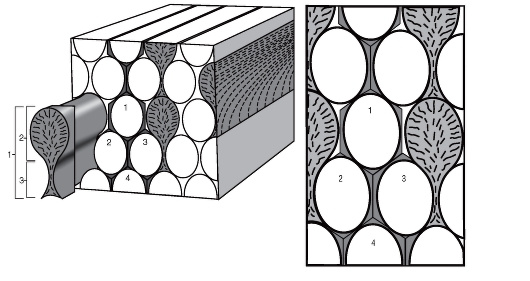
Enamel prism
The main structural element is the enamel prism, which consists of packed crystals, mainly hydroxyapatite. In addition, each crystal is covered with a hydration shell with a thickness of about 1 nm, and a small amount of free water between them makes it possible to transfer ions between the hard tissues of the tooth and saliva.
Dentine
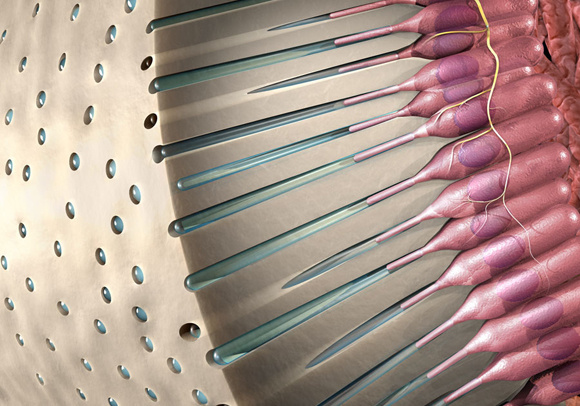
Odontoblasts, their processes and dentinal tubules

Dentinal tubules, electron microscopy

Dentin contains much less mineral matter (69%) and a lot of moisture (13.2%). It also has an ordered structure. From the pulp it penetrates the thin tubules. In these tubules are the long "tails" of odontoblast cells, which mainly live inside the tooth in the pulp. Moreover, the fluid in these tubules is actively involved in ion exchange and is an important element of the hydraulic transmission of mechanical pressure to the pulp receptors. Roughly speaking, when the dentist gently presses your knee without anesthesia, gently crushing you with your knee, you will begin to howl and toss when crossing the border of the dentin and enamel. Odontoblasts do not like being pulled by the tail. Enamel preparation is almost painless.
Carious monsters and plaque
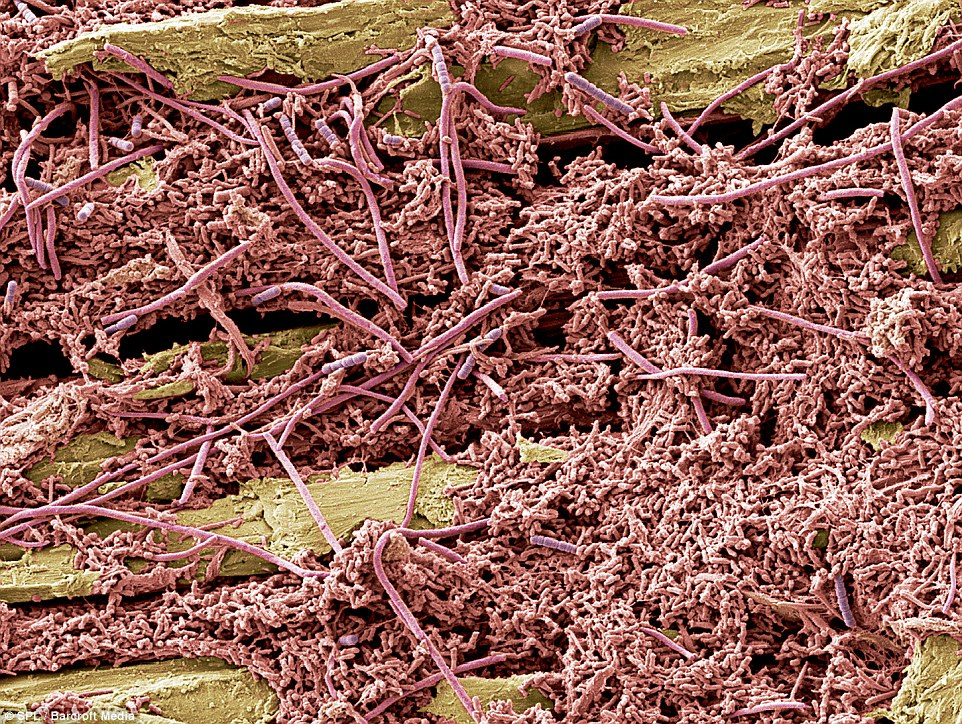
Plaque. Scanning electron microscopy. Long strings are hyphae of actinomycete fungi. Yes, almost like mold
In the mouth we still have that zoo, consisting of a variety of bacteria, protozoa and fungi. Is that only algae do not grow. On the one hand, we have completely come to terms with this and we coexist with them for millions of years with varying success. On the other - the slightest variant of the fall of immunity, a change in diet or saliva composition can lead to very unpleasant consequences.
So, you woke up in the morning and somehow brushed your teeth. Yes, most oddly do not know how to do it normally. In particular, during inspections, one constantly finds deposits of a carefully left, slightly petrified plaque in the region of the third molars, which are “wisdom teeth”. Many do not go there with a toothbrush. In general, we brushed our teeth with varying degrees of success. In a few hours a so-called pellicle will form. This is a thin film with a thickness of less than 1 micron, consisting of various proteins of saliva, immunoglobulins and other components of saliva. It forms a semipermeable membrane, which also participates in ion exchange with oral fluid. After some time, the most diverse bacteria that live in your mouth begin to precipitate on the pellicle. In particular, actinomycetes are among the first to adhere to the surface. They very quickly scatter the hyphae of their "mycelium" on the enamel surface, creating conditions for the adhesion of other microorganisms. To smooth enamel is much more difficult to cling to, than to the matted mycelium of the fungus.

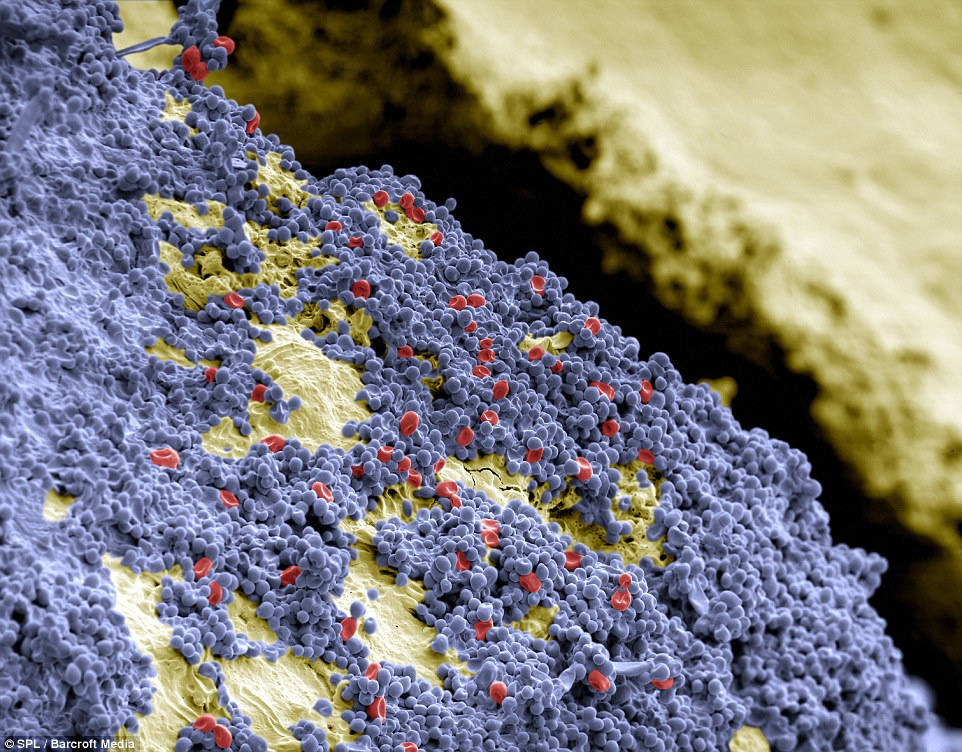
The main villain, Streptococcus mutans on the surface of the tooth. Single red blood cells. The person has bleeding problems already
But those who come after may already create us a lot of problems. Especially the so-called Streptococcus mutans, which is considered one of those who make the greatest contribution to the formation of caries. Bacteria-saprophytes, in fact, we do not particularly evil. This is not Yersinia pestis, which happily mowed whole countries with plague. Saprophytes live quietly and eat up on us the remnants of our hamburgers. But the problem is that they not only eat, but also defecate throw waste products into the environment. And they, unfortunately, very sour. Lactic, succinic, malic and a bunch of other organic acids. Everyone remembers the classic chicken egg experience with acid? Insoluble calcium salts safely go into solution and fly away to unknown distances. Fortunately, evolution wisely killed those poor little animals that lost teeth due to caries in the first years of life. Those who survived developed mechanisms to protect against acid damage to the enamel. Oddly enough, but the key factor here is our saliva. It acts as a pH buffer due to bicarbonates and other substances, allowing you to keep the acidity at an acceptable level. In addition, the salivary glands take a significant amount of calcium ions from the blood and throw them into the oral cavity. As a result, balance comes. Careless bacteria eat everything and eat holes with their acid, and calcium ions from saliva quickly patch it back.
The problem is that the balance is very fragile. For example, a crap diet low in calcium. Well, man does not eat meat and dairy products. Or pregnancy, when the child takes away from the mother's body all that he needs, dramatically reducing the amount of calcium in the expectant mother. And there is also an option evil fighting strains aggressive forms of bacteria that multiply very actively and produce a lot of acids. In short, sadness occurs when the process of demineralization begins to prevail over remineralization . From this point on, the only question is when the mineral component of the enamel will be eaten by cute little animals and they will begin their fascinating journey into the unknown depths of your tooth.

Caries under the electron microscope. Visible structural fibers in the demineralization zone
Stages of caries development:
- Caries in stains;
- Superficial caries;
- Average caries;
- Deep caries;
Caries at the stains stage looks like exposed protein fibers from which hydroxyapatite has been washed down with acid. However, not everything is so sad. In the first stage, caries is a reversible problem and can be completely cured without using so much humming dental burs in the heart. But then the bacteria will happily begin to spread cone deep into, forming drop-shaped cavities. This is due to the fact that the mineralization of tooth tissues decreases with increasing depth. The most stable layer of protection is the outer one. It contains a lot of acid-resistant fluorapatite, if you are lucky with normal water in childhood.
Paint your teeth

Caries at the stage of stains. Visible defect in normal lighting (A) and in transmission with powerful LED backlight (B)
We have already decided that the maximum stage of caries we can afford is the stage of stains. Until the structure of organic fibers is broken, there is still a chance to remineralize everything back. The illustration above is a typical example. By the way, the easiest way to distinguish demineralization from, say, hypoplasia or fluorosis is to try painting it. Usually for this purpose aniline dyes are used. For example, methylene blue. You can hard-paint a tooth with brilliant green, why not? The meaning of this disgrace is that normal enamel does not perceive dye in contrast to exposed organic structures. Therefore, by the way, chronic caries looks like a black speck. It absorbs pigments from food.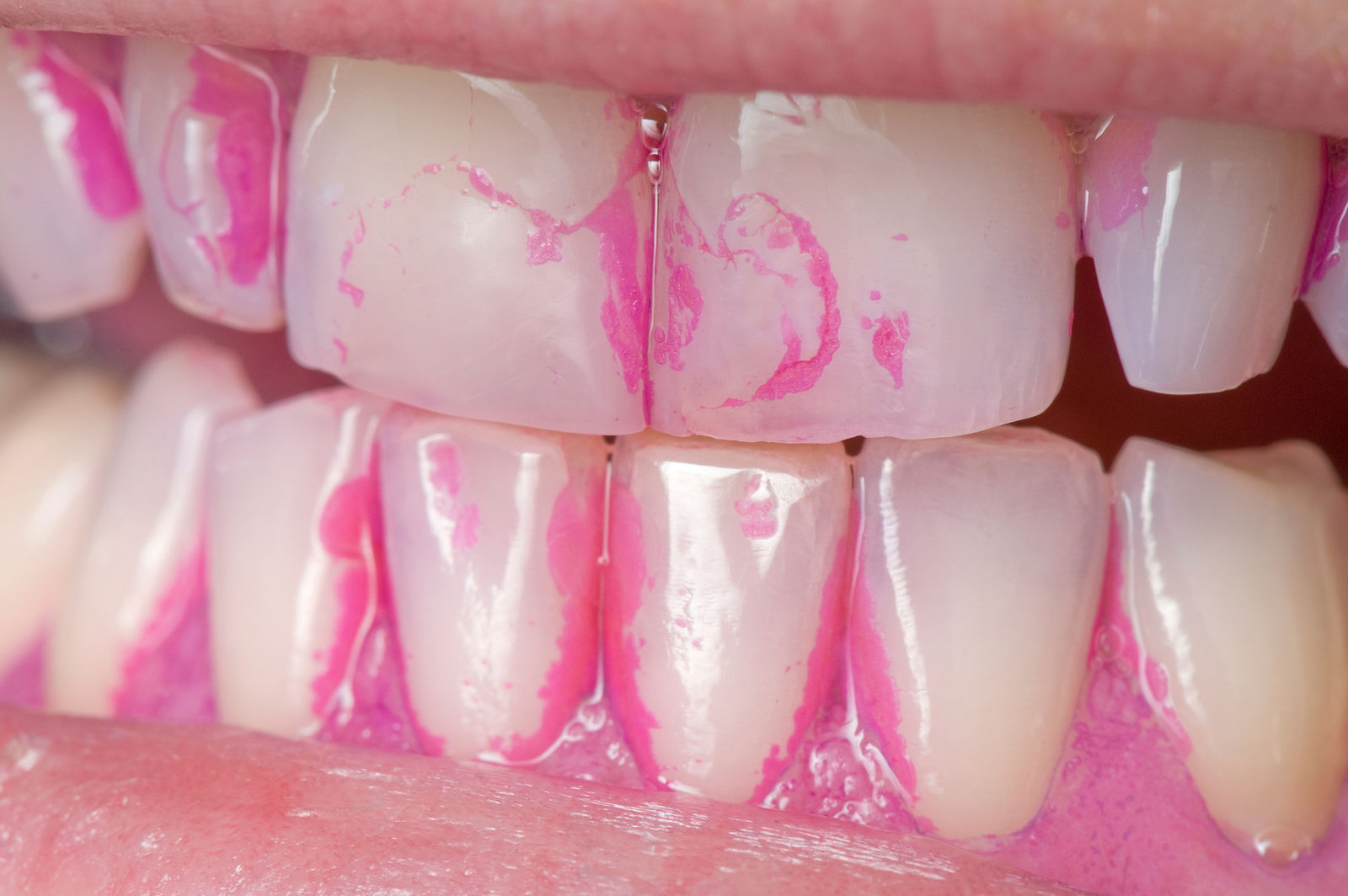
Here caries on the stains stage are colored with something like fuchsin
In addition to the demineralization zones, plaque will also be painted. You can immediately see how bad you brush your teeth, especially in the area of the gums. All this entertainment is quite affordable at home. For this you will need tablets "Dinal."

They just need to chew and rinse your mouth after. For some reason, we, for some reason, extremely unnerved people in a crowded trolleybus, blowing bloody foam after these red pills.
We rub a finger
When we determined the presence of demineralization foci, the next logical step would be to pour the calcium back in an accessible form. This is in addition to traditional tips on hygiene and an increase in calcium in food.
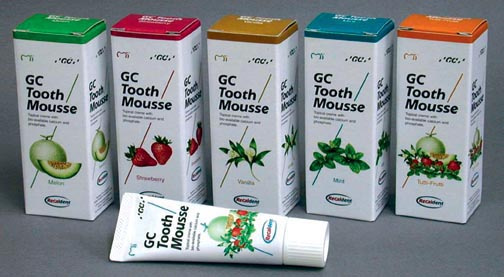
I am extremely pleased with GC Tooth Mousse. It is easiest to get it in stores for dentists. Alas, has risen in price. But it works really well. I had several patients with a bunch of small lesions all over the enamel after removing the braces. One tube was enough for about a month course, after which everything passed. It makes sense to use it from time to time, especially if you are pregnant or you have something with calcium that did not occur in food (most often in vegans). As for tastes: mint and strawberry are the most optimal in my opinion. Vanilla is terribly cloying, and tutti-frutti in general is terribly synthetic rubbish. But this is my opinion)
The application is extremely simple. We brushed our teeth for the night and with a stupid finger evenly spread it on all surfaces. Sleep diligently, trying not to eat pasta as long as possible.
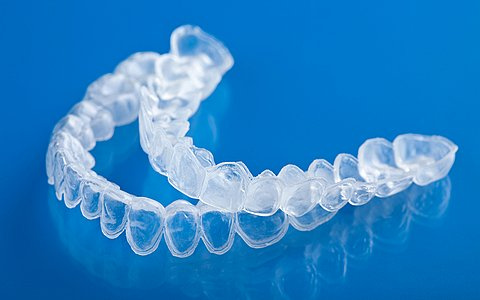
In principle, one can proceed even more reasonably and order the production of an individual capa once. Then the paste will linger on the surfaces even longer, which will enhance the effect. There are no specific contraindications, except for allergy to milk protein and other components. You can eat right there, but there’s no special meaning.
Fluoridate enamel
Surely many people remember the harsh Soviet nitro enamels fluoride for enamel coating. Pleasant yellow-brown color. Elegant flakes of lacquer, which scabs off your incisors with each smile. Now everything is much more boring. The biggest problem with classic lacquers is the surface effect. The meaning of fluorination is to replace the hydroxyl group with fluorine and create acid-resistant fluorapatite in the enamel. Some time ago, a group of drugs for ultra-deep microfluorination appeared. For the first time, I came across a perceptibly expensive German enamel-sealing liquid.

Then our manufacturers very quickly pulled up and released Gluftored. All this mess works in two stages. Before fluoridation carry out full cleaning. Then, a first solution containing copper and fluoride ions is applied to the dried enamel. Wait until absorbed and meditate. Then the second composition is applied with an applicator - a suspension of calcium hydroxide. As a result of the reaction, fluoride crystals precipitate inside the enamel, at the same time sealing all micropores. Amazing effect in terms of hypersensitivity. After the second procedure, most of the problems, even in the most difficult cases, go away completely. Plus, unlike varnishes, a long-lasting effect and a depot of fluorine in the hard tissues of the teeth.
This stage is best done directly at the dentist. Although very upset individuals can try to repeat it at home with the help of lumps of cotton and a hair dryer, but I would still insist on a normal visit to the doctor. At the same time you will pass a routine inspection. Fluoridation is best performed after remineralization, since sealing will worsen the penetration of calcium ions from the paste.
Gnawing root vegetables

There is another very important point - our diet. Not once saw fans grind everything in mashed potatoes "to be better assimilated" or other similar oddities. The problem here is that our teeth are sharpened for self-cleaning in the process of chewing hard stems, fruits and other root crops. And the food of a city dweller, often consisting of hamburgers, does not contribute to this.
Many have heard that "teeth are deteriorating" from sweet. In fact, everything is different. Imagine that you are swimming in a large pool. I want to eat. And then, suddenly, a powerful stream gave the soup. And then, just as suddenly, the soup ended, although you are still trying to catch a couple of potatoes frantically from the stream. The bacterium feels the same way when you eat a piece of sugar or drink a sip of sweet water. Saliva very quickly flushes farther into the stomach. The real paradise for our saprophytes is buns. Delicious, crispy cinnamon buns and similar products. They gently wrap your teeth in a wonderful nutritious veil, giving food to the trillions of hungry people. The consequences are clear to everyone. Therefore, carrots, apples, Jerusalem artichoke, in the end - your best friends.
Separately, I wanted to warn fans of citrus fresh juices. If you think that it is very useful, then you are deeply mistaken. Try to drink at least through a straw. Citric acid not only scale in the kettle quickly dissolves. I wanted to add a hardcore illustration of acid enamel necrosis , but I decided that it would be too much. Google yourself if you have a mood. I actually saw the girl, whom my mother brought to life with freshly painted semi-enamel.
PS Do not forget about good hygiene. Otherwise come carious monsters.
')
Source: https://habr.com/ru/post/403731/
All Articles